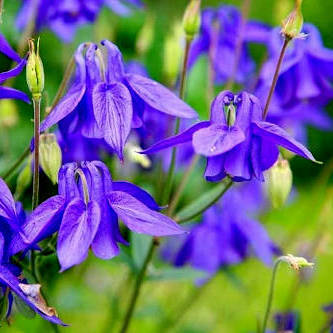Columbine plants (Aquilegia spp.) are beautiful and versatile perennial plants that are commonly grown for their unique and attractive flowers. They belong to the Ranunculaceae family and come in a variety of species and cultivars. Here are some of the uses and qualities of Columbine plants:
- Ornamental Purposes: Columbines are primarily grown as ornamental plants in gardens, landscapes, and flower beds. They add a touch of elegance and colour to the surroundings with their distinctive, spurred flowers. The flowers come in various colours, including shades of blue, purple, pink, red, yellow, and white, often with contrasting inner petals and spurs.
- Attracts Pollinators: The tubular-shaped flowers of Columbine are attractive to bees, butterflies, and hummingbirds. They serve as an important source of nectar for these pollinators, making them valuable additions to pollinator-friendly gardens.
- Self-Seeding: Columbine plants are known for their ability to self-seed. Once established, they can readily produce seeds that fall to the ground and germinate, leading to new plants in the following seasons. This characteristic can create naturalized patches of Columbines in the garden over time.
- Versatility: Columbine plants can thrive in various growing conditions, depending on the species and cultivar. They can be grown in full sun to partial shade, making them suitable for a wide range of garden settings.
- Long Blooming Season: Columbines typically have a long blooming season, extending from late spring to early summer. This extended flowering period ensures a vibrant display of colours in the garden for several weeks.
- Hardy Perennial: Columbine plants are often considered hardy perennials, meaning they can withstand winter conditions and continue to grow and bloom in the following growing seasons. Their hardiness varies by species and cultivar, so it's essential to select varieties appropriate for your climate.
- Cut Flowers: The unique and attractive flowers of Columbine can be cut and used in floral arrangements, adding a touch of elegance and charm to bouquets and vase displays.
- Medicinal Uses: Some species of Columbine have historical medicinal uses, although caution is advised as they contain toxic compounds. Traditional herbal medicine used Columbine for various purposes, such as treating skin conditions and digestive issues. However, modern medical practices generally do not use Columbine for medicinal purposes.
It's worth noting that while Columbine plants are generally safe to handle, all parts of the plant contain toxic compounds, including alkaloids and glycosides. Therefore, it's essential to keep them out of the reach of children and pets, and avoid ingesting any parts of the plant.
